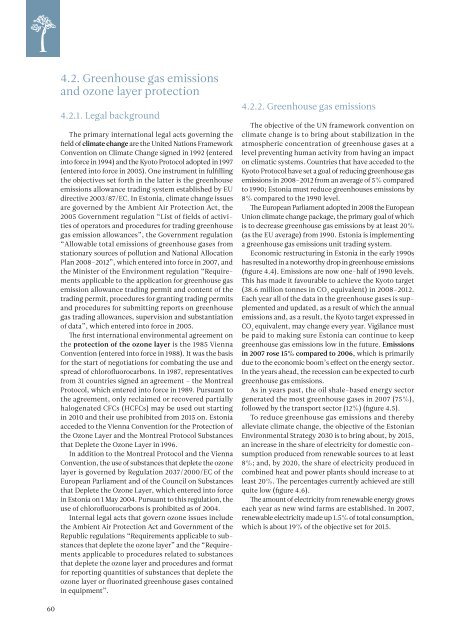ESTONIAN ENVIRONMENTAL REVIEW 2009
ESTONIAN ENVIRONMENTAL REVIEW 2009
ESTONIAN ENVIRONMENTAL REVIEW 2009
Create successful ePaper yourself
Turn your PDF publications into a flip-book with our unique Google optimized e-Paper software.
4.2. Greenhouse gas emissions<br />
and ozone layer protection<br />
4.2.1. Legal background<br />
The primary international legal acts governing the<br />
field of climate change are the United Nations Framework<br />
Convention on Climate Change signed in 1992 (entered<br />
into force in 1994) and the Kyoto Protocol adopted in 1997<br />
(entered into force in 2005). One instrument in fulfilling<br />
the objectives set forth in the latter is the greenhouse<br />
emissions allowance trading system established by EU<br />
directive 2003/87/EC. In Estonia, climate change issues<br />
are governed by the Ambient Air Protection Act, the<br />
2005 Government regulation “List of fields of activities<br />
of operators and procedures for trading greenhouse<br />
gas emission allowances”, the Government regulation<br />
“Allowable total emissions of greenhouse gases from<br />
stationary sources of pollution and National Allocation<br />
Plan 2008–2012”, which entered into force in 2007, and<br />
the Minister of the Environment regulation “Requirements<br />
applicable to the application for greenhouse gas<br />
emission allowance trading permit and content of the<br />
trading permit, procedures for granting trading permits<br />
and procedures for submitting reports on greenhouse<br />
gas trading allowances, supervision and substantiation<br />
of data”, which entered into force in 2005.<br />
The first international environmental agreement on<br />
the protection of the ozone layer is the 1985 Vienna<br />
Convention (entered into force in 1988). It was the basis<br />
for the start of negotiations for combating the use and<br />
spread of chlorofluorocarbons. In 1987, representatives<br />
from 31 countries signed an agreement – the Montreal<br />
Protocol, which entered into force in 1989. Pursuant to<br />
the agreement, only reclaimed or recovered partially<br />
halogenated CFCs (HCFCs) may be used out starting<br />
in 2010 and their use prohibited from 2015 on. Estonia<br />
acceded to the Vienna Convention for the Protection of<br />
the Ozone Layer and the Montreal Protocol Substances<br />
that Deplete the Ozone Layer in 1996.<br />
In addition to the Montreal Protocol and the Vienna<br />
Convention, the use of substances that deplete the ozone<br />
layer is governed by Regulation 2037/2000/EC of the<br />
European Parliament and of the Council on Substances<br />
that Deplete the Ozone Layer, which entered into force<br />
in Estonia on 1 May 2004. Pursuant to this regulation, the<br />
use of chlorofluorocarbons is prohibited as of 2004.<br />
Internal legal acts that govern ozone issues include<br />
the Ambient Air Protection Act and Government of the<br />
Republic regulations “Requirements applicable to substances<br />
that deplete the ozone layer” and the “Requirements<br />
applicable to procedures related to substances<br />
that deplete the ozone layer and procedures and format<br />
for reporting quantities of substances that deplete the<br />
ozone layer or fluorinated greenhouse gases contained<br />
in equipment”.<br />
4.2.2. Greenhouse gas emissions<br />
The objective of the UN framework convention on<br />
climate change is to bring about stabilization in the<br />
atmospheric concentration of greenhouse gases at a<br />
level preventing human activity from having an impact<br />
on climatic systems. Countries that have acceded to the<br />
Kyoto Protocol have set a goal of reducing greenhouse gas<br />
emissions in 2008–2012 from an average of 5% compared<br />
to 1990; Estonia must reduce greenhouses emissions by<br />
8% compared to the 1990 level.<br />
The European Parliament adopted in 2008 the European<br />
Union climate change package, the primary goal of which<br />
is to decrease greenhouse gas emissions by at least 20%<br />
(as the EU average) from 1990. Estonia is implementing<br />
a greenhouse gas emissions unit trading system.<br />
Economic restructuring in Estonia in the early 1990s<br />
has resulted in a noteworthy drop in greenhouse emissions<br />
(figure 4.4). Emissions are now one-half of 1990 levels.<br />
This has made it favourable to achieve the Kyoto target<br />
(38.6 million tonnes in CO 2<br />
equivalent) in 2008–2012.<br />
Each year all of the data in the greenhouse gases is supplemented<br />
and updated, as a result of which the annual<br />
emissions and, as a result, the Kyoto target expressed in<br />
CO 2<br />
equivalent, may change every year. Vigilance must<br />
be paid to making sure Estonia can continue to keep<br />
greenhouse gas emissions low in the future. Emissions<br />
in 2007 rose 15% compared to 2006, which is primarily<br />
due to the economic boom’s effect on the energy sector.<br />
In the years ahead, the recession can be expected to curb<br />
greenhouse gas emissions.<br />
As in years past, the oil shale-based energy sector<br />
generated the most greenhouse gases in 2007 (75%),<br />
followed by the transport sector (12%) (figure 4.5).<br />
To reduce greenhouse gas emissions and thereby<br />
alleviate climate change, the objective of the Estonian<br />
Environmental Strategy 2030 is to bring about, by 2015,<br />
an increase in the share of electricity for domestic consumption<br />
produced from renewable sources to at least<br />
8%; and, by 2020, the share of electricity produced in<br />
combined heat and power plants should increase to at<br />
least 20%. The percentages currently achieved are still<br />
quite low (figure 4.6).<br />
The amount of electricity from renewable energy grows<br />
each year as new wind farms are established. In 2007,<br />
renewable electricity made up 1.5% of total consumption,<br />
which is about 19% of the objective set for 2015.<br />
60

















